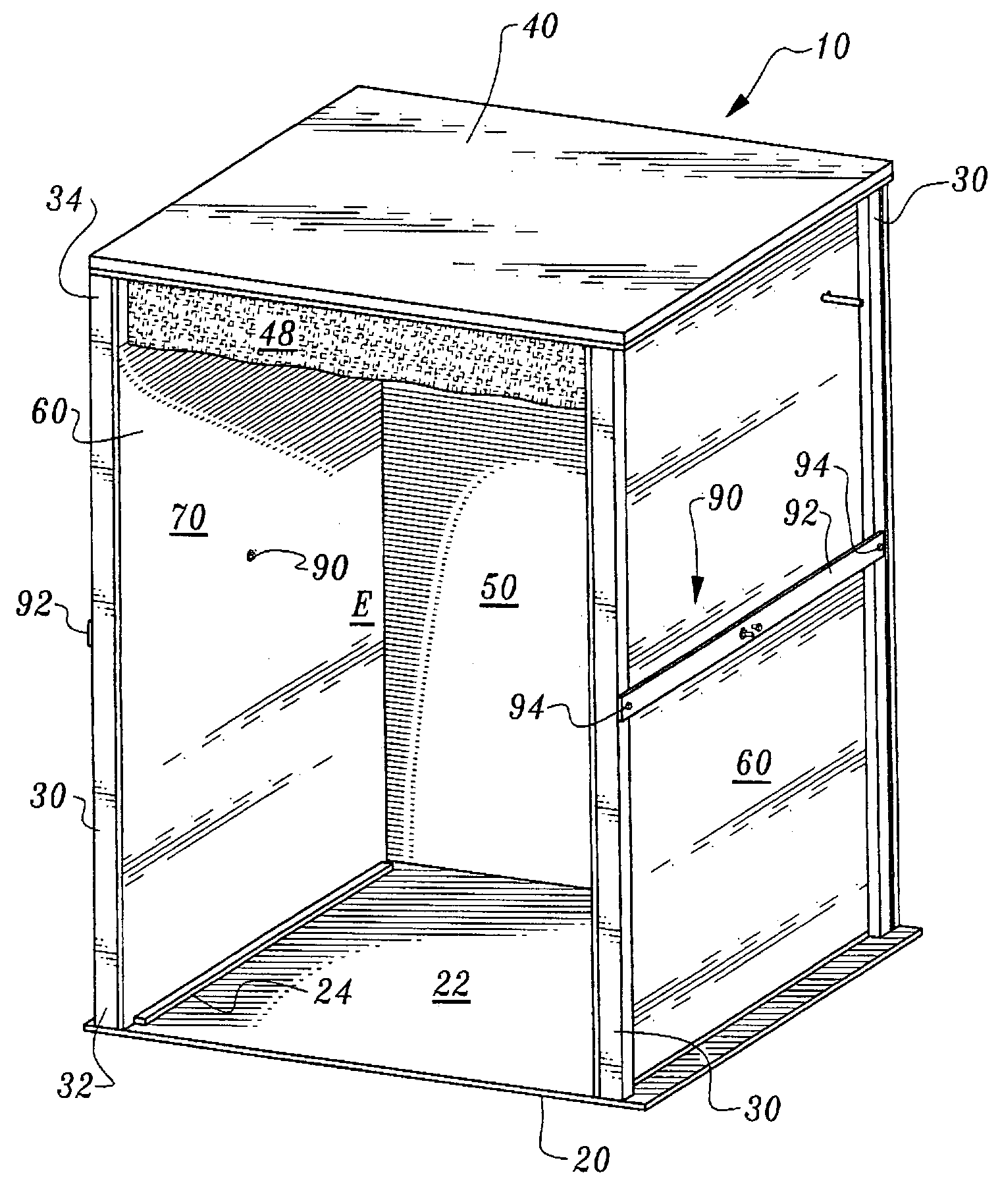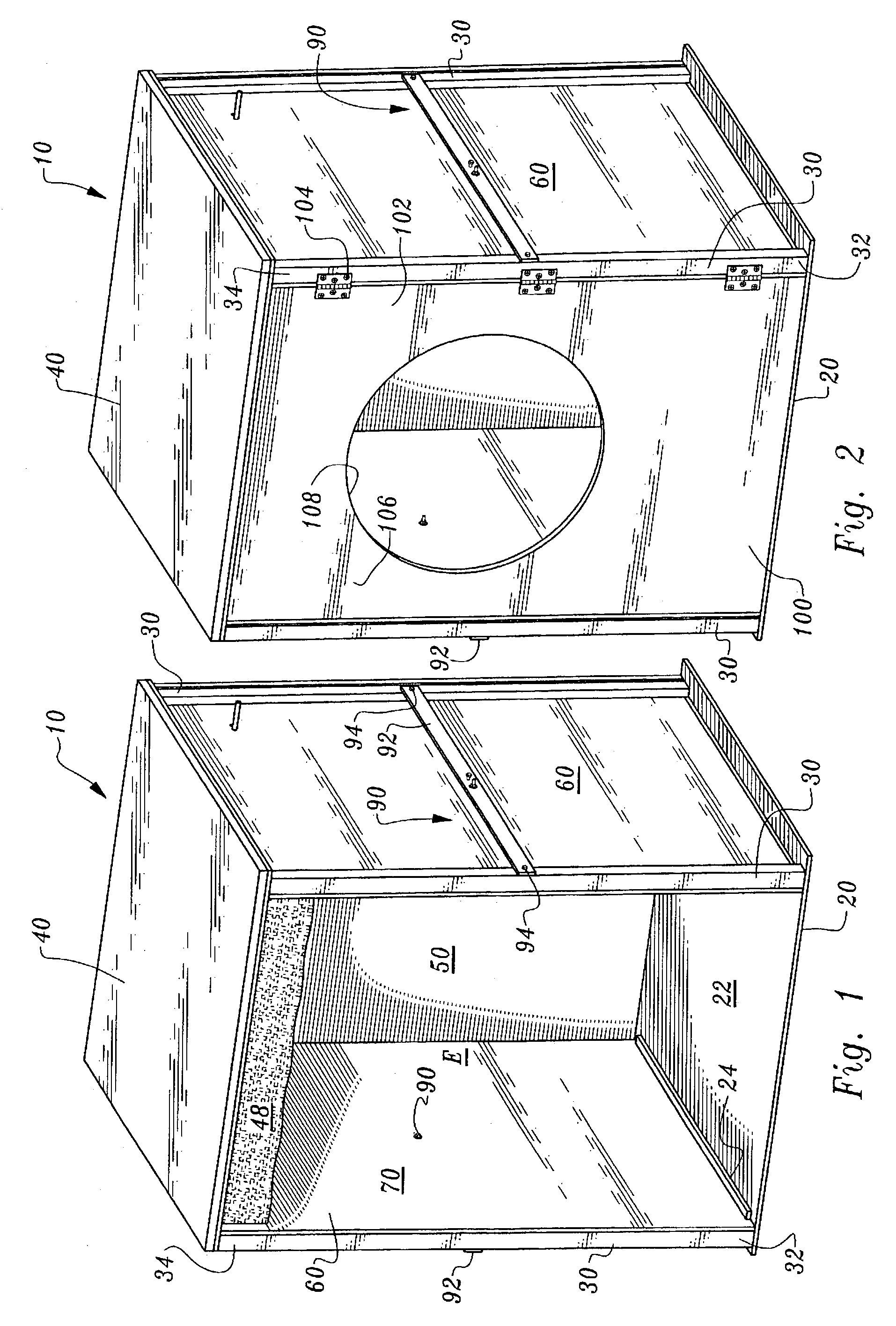Thermodynamic resonance enclosure
a technology of thermodynamic resonance and enclosure, which is applied in the field of enclosures, can solve the problems of requiring large amounts of electric or other energy to operate according to the design, affecting the comfort of the occupants of the residence, and affecting the comfort of the occupants, so as to achieve the effect of maximum thermodynamic resonance, minimal construction experience, and convenient us
- Summary
- Abstract
- Description
- Claims
- Application Information
AI Technical Summary
Benefits of technology
Problems solved by technology
Method used
Image
Examples
example 1
[0073]An enclosure has interior dimensions of 1.5 hydrogen cubits (H. C.) or approximately 37 9 / 16 inches in width, 2.5 hydrogen cubits (H. C.) or approximately 62 9 / 16 inches in height and 1.5 hydrogen cubits in depth. The sides and rear wall consist of ½ inch thick composition board with a paper veneer-like finish. The interior of the side is lined with 0.006 inch thick copper foil. The interior is partially lined with 0.006 inch thick copper foil consisting of an 18.75 inch radius quarter circle in the upper rear corner, plus vertical four inch wide strips of copper foil and horizontal four inch wide strips of copper foil. The interior of the back of the box is partially lined with 0.006 inch thick copper foil consisting of two 18.75 inch radius quarter circles, one in each upper corner of the back of the box. The remainder of the back of the interior of the box is lined with a heat reflecting material consisting of 0.0005 inch thick plastic, coated with aluminum or silver (silve...
example 2
[0086]A second enclosure is provided larger than the box / enclosure of example 1. This box has interior dimensions of two hydrogen cubits or about 50 1 / 16 inches wide, 2½ hydrogen cubits or about 62 9 / 16 inches high and about forty-eight inches long. This box has a front door which closes most of the front of the box but leaving approximately a two inch wide slit at one side of the door for ventilation. The door is hinged at one side to provide easy access to the box. The door has a forty-two inch diameter circular window disposed about at the center of the door. The door is made of approximately ½ inch thick plywood and the window is ½ inch thick glass. The sides and rear wall of the box are made of ¼ inch thick pressed hard board referred to by the trademark Masonite.
[0087]One inch thick polystyrene foam plastic sheets are cemented to the exterior of these Masonite panels for insulation. Since the Masonite panels have a tendency to warp or oil-can a little, means are provided for m...
example 3
[0101]The box of example three is a horizontal version of the box / enclosure concept designed for lying down and sleeping rather than sitting up and watching television, reading or working. The interior dimensions are 1½ hydrogen cubits high (about 37 9 / 16 inches) by 1½ hydrogen cubits wide by three hydrogen cubits long (75 plus inches). Similar to the enclosure of example two, the enclosure of example three is constructed of dimensionally stable material such as plywood or Masonite, lined on the outside with foam plastic insulation board or other appropriate insulation material and lined on the inside with heat reflecting material such as aluminum foil, copper foil, heat reflecting paint or sheet plastic coated with a good infrared reflecting material such as aluminum, silver or gold. The heat reflecting lining material on the interior top of ceiling of the box is thicker than the material on the sides so it is a good conductor of heat as well as a good reflector of heat. The heat r...
PUM
 Login to View More
Login to View More Abstract
Description
Claims
Application Information
 Login to View More
Login to View More - R&D
- Intellectual Property
- Life Sciences
- Materials
- Tech Scout
- Unparalleled Data Quality
- Higher Quality Content
- 60% Fewer Hallucinations
Browse by: Latest US Patents, China's latest patents, Technical Efficacy Thesaurus, Application Domain, Technology Topic, Popular Technical Reports.
© 2025 PatSnap. All rights reserved.Legal|Privacy policy|Modern Slavery Act Transparency Statement|Sitemap|About US| Contact US: help@patsnap.com



